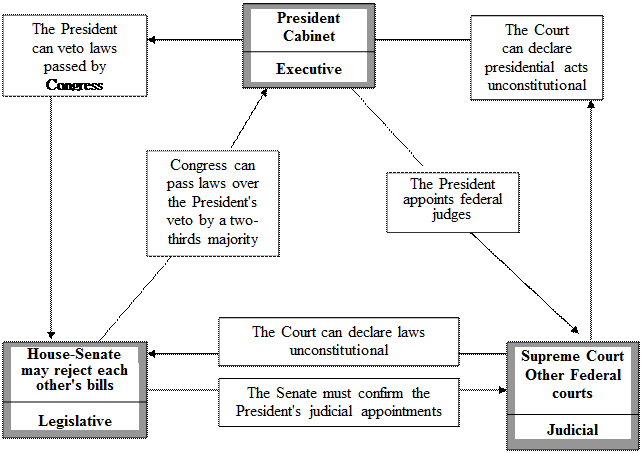
CATEGORIES:
BiologyChemistryConstructionCultureEcologyEconomyElectronicsFinanceGeographyHistoryInformaticsLawMathematicsMechanicsMedicineOtherPedagogyPhilosophyPhysicsPolicyPsychologySociologySportTourism
TEXT 5: THE SYSTEM OF CHECKS AND BALANCES
The Constitution provides for three main branches of government which are separate and distinct from one another. The powers given to each are carefully balanced by the powers of the other two. Each branch serves as a check on the others. This is to keep any branch from gaining too much power or from misusing its powers. The figure below illustrates how the equal branches of government are connected and how each is dependent on the other two.
Congress has the power to make laws, but the President may veto any act of Congress. Congress, in its turn, can override a veto by a two-thirds vote in each house. Congress can also refuse to provide funds requested by the President. The President can appoint important officials of his administration, but they must be approved by the Senate. The President also has the power to name all federal judges; they, too, must be approved by the Senate. The courts have the power to determine the constitutionality of all acts of Congress and of presidential actions, and to strike down those they find unconstitutional.
The system of checks and balances makes compromise and consensus necessary. Compromise is also a vital aspect of other levels of government in the United States. This system protects against extremes. It means, for example, that new presidents cannot radically change governmental policies just as they wish. In the US, therefore, when people think of "the government", they usually mean the entire system, that is, the Executive Branch and the President, Congress, and the courts. In fact and in practice, therefore, the President (i.e. "the Administration") is not as powerful as many people outside the US seem to think he is. In comparison with other leaders in systems where the majority party forms "the government", he is much less so.
Figure 3
The Separation of Powers
Checks and Balances

SUMMARY OF THE UNIT
- The National Government in the USA is divided into three separate branches: legislative, executive and judicial.
- The bicameral legislative branch of the federal government is made up of the Senate and the House of Representatives. One hundred Senators and 435 Representatives are charged with making laws for the nation. Congress also checks the power of the other two branches of government.
- The executive branch has the responsibility to carry out the law, it is headed by the President. The President also serves as chief of state, chief executive, Commander in Chief, chief diplomat, legislative leader, judicial leader, and leader of his or her political party. Nearly 3 million members of the bureaucracy, including those in executive departments and independent agencies, help the President carry out these duties.
- The judicial branch of the federal government interprets the law. This branch is organized into lower federal courts, including district courts and courts of appeal, and the Supreme Court. Federal courts hear many kinds of cases, including those involving the Constitution and federal laws.
UNIT II
Date: 2015-01-12; view: 6954
| <== previous page | | | next page ==> |
| TEXT 4: THE NATIONAL JUDICIAL BRANCH | | | TEXT 1: STATE CONSTITUTIONS |